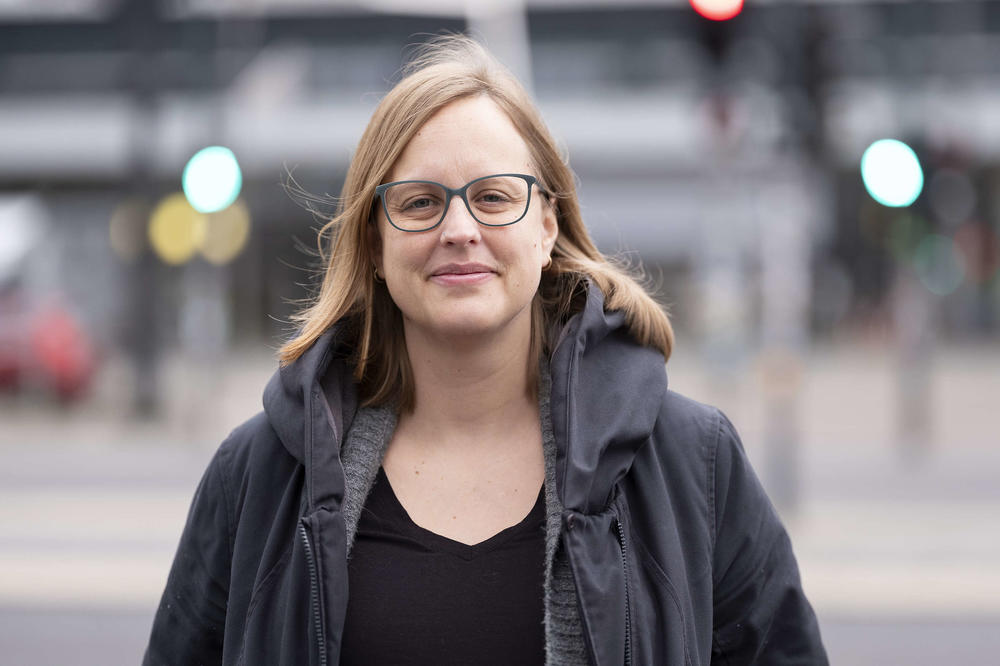When Function Follows Form
Myfanwy Evans investigates the geometry of materials down to the nanoscale.
May 16, 2019
The Australian scientist appreciates Berlin’s dynamic research community.
Image Credit: Matthias Heyde
There are many ways to look at the world: above all Myfanwy Evans perceives the different shapes and structures that an object can take. This is not least due to her scientific background. A native of Australia, she studied mathematics at the Australian National University in Canberra, where she also completed her PhD in interdisciplinary science. Since then, the 34-year-old has beenworking on the geometry and topology of materials.
“I am an extremely visual person and have always been very interested in the forms and structures of nature,” says Evans. In 2011, she came to University of Erlangen- Nuremberg with a Humboldt Research Fellowship. In 2015 she started her own Emmy Noether junior research group at Technische Universität Berlin. “I wanted to live in a big city with a lively and dynamic scientific community – Berlin offers this like no other city in Germany. At the TU I work together with outstanding colleagues. I enjoy the intensive exchange, for example at the regular lunches of all female faculty and students at the Berlin Mathematical School.”
“My approach to scientific topics is fundamentally interdisciplinary”
With her PhD in “Interdisciplinary Science” – a combination of mathematics, physics, biology, and materials science – she is not only predestined for research in the Excellence Cluster MATH+, but also for another new Berlin cluster called “Matters of Activity.” Myfanwy Evans says, “My approach to scientific topics is fundamentally interdisciplinary: I look at the questions and consider what tools I need to solve the problem. These can be methods from geometry and mathematics in general, but also from biophysics, materials science or technology.” At the core of her scientific interest lies geometry, the various forms found in nature, and topology, which examines how these forms are interconnected. “These two mathematical areas are usually very theoretical and abstract. My approach is to analyze, understand, and learn from geometric shapes and patterns inspired by nature for various applications.”
Questions such as “Which shapes are found in the microstructure of the material” or “How can these shapes be described mathematically,” drive her everyday research. “The macroscopic physical properties of materials, whether foams, polymer melts, steel, or ceramics, are largely determined by their internal microstructure. I am interested in what effects these forms and the specific topology have on the material, its function or stability,” explains the mathematician,who was awarded the BerlinYoung Scientist Prize of the Governing Mayor for her research in 2017.
Her current project within the mathematics cluster Math+, which she is working on together with her colleagues Francisco Garcia-Moreno, Frank Lutz, and John Sullivan, is not about natural materials, but about so-called metallic foams. “Certain metals are melted and foamed like bath foam. This creates a particularly light, elastic, and stable material, which is used, for example, in the construction of electric cars,” explains the scientist. Understanding the microstructure of these materials, in particular their geometric and topological characteristics, is complicated.“We want to use current methods of stochastic and computational geometry and topology to gain further insights into these materials and to utilize the resulting creative mathematical ideas.”
First, appropriate analysis techniques must be developed and tested on a wide variety of materials. The aim is to correctly describe microstructures in the range of objects a few nanometers in size using geometric and topological methods and to find out which structures influence the material properties. The findings will then be applied to metal foams: “If we learn something about material properties through its microstructure geometry, we can also infer improved processing techniques for specific desired outcomes of the material,” explains the Australian mathematician.
This text originally appeared on February 22, 2019, in a Tagesspiegel newspaper supplement published by Freie Universität Berlin, Humboldt-Universität zu Berlin, Technische Unversität Berlin, and Charité - Universitätsmedizin Berlin.
Further Information
Mathematics for technical innovations
The MATH+ Cluster of Excellence of the universities Freie Universität Berlin, Humboldt Universität zu Berlin and Technische Universität Berlin, focuses on research into the mathematical basis for the use of large amounts of data in life and materials sciences, energy and network research, as well as in humanities and social sciences. Both science and technological innovations are to be considered. The interdisciplinary MATH+ community includes 25 researchers and twelve young scientists. They will work together in 52 current projects with a total of around 100 participating groups. They aim to create six new professorships, six junior research groups, and 13 postdoctoral and 66 doctoral positions.

